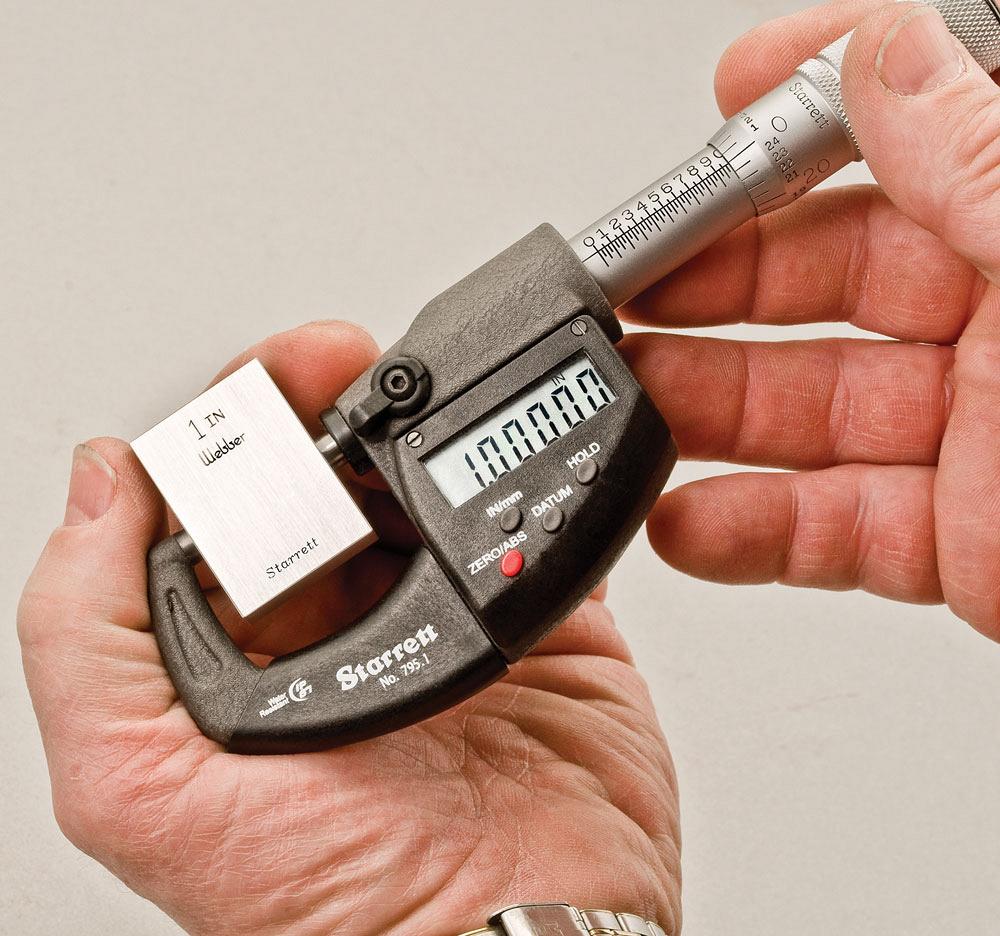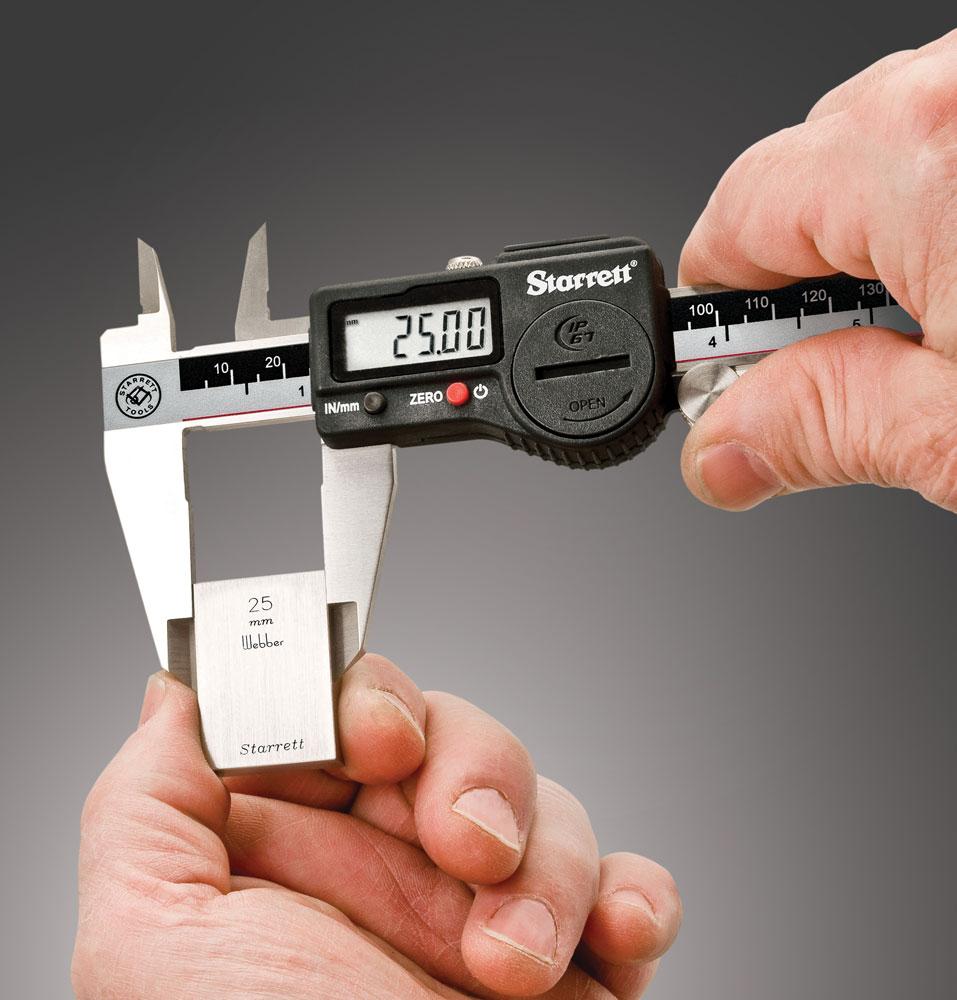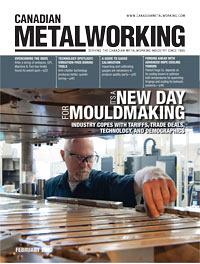Associate Editor
- FMA
- The Fabricator
- FABTECH
- Canadian Metalworking
A guide to gauge calibration
Inspecting and calibrating gauges is necessary to produce quality parts
- By Lindsay Luminoso
- February 7, 2019
- Article
- Measurement

Precision gauge blocks are used for calibrating precision measuring tools and for setting numerous comparative-type gauges used in incoming, production, and final inspection areas. Photo courtesy of The L.S. Starrett Co.
When it comes to measurement and inspection, if a part is out of tolerance, an operator may be quick to blame the machine or manufacturing process. Rarely does an operator consider that a gauge or hand tool could be the problem. However, these measurement devices frequently are used, and often in harsh environments, making them susceptible to inconsistent results. In a manufacturing environment focused on producing quality parts with tight tolerances, gauge and hand tool calibration is necessary for success.
Traceable calibration helps ensure operators have confidence in their measurement equipment and results. A hand tool improperly calibrated presents a safety and quality issue.
"Operators must ensure parts are produced with the right tolerances, accuracy, and reliability," said Martin McKinnon, corporate quality manager, Starrett Calibration Services, Duncan, S.C. "Users also need to have confidence in the measurements they’re making. For example, if an operator measures a part in Ohio and another operator measures that same part in Canada, an inch needs to be an inch. That’s where calibration comes into play."
Like anything else, tools wear, and it’s not always a predictable wear. Anytime one surface makes contact with another, whether that’s through a sliding component or a screw thread, wear can occur. Calibration is used to determine just how much wear has occurred since the tool was last calibrated. This helps operators to review and see how much change or distortion has occurred in the device and if it is enough to cause inconsistent measurement results.
If a gauge or hand tool is determined to be out of tolerance, shops may be required to reinspect all the parts measured with that device. This can be both time-consuming and expensive if the recall proves many of the parts need to be remanufactured.
WHEN TO CALIBRATE
Daily inspection of gauges is important to ensure these tools are fit to be used.
"Ideally, every time an operator picks the tool up, he should perform a field check issue, especially if the tool is issued from a tool crib," said Dexter Carlson, chief inspector and head of the calibration laboratory, The L.S. Starrett Co., Athol, Mass. "Every tool has some sort of a field check that can be performed. A red flag should pop up if there are inconsistencies in any of the results from the field check."
Tools used at the machine or in harsh environments should be scrutinized for any visible signs that calibration is needed. This can be done before use by checking for the zero-point position, a pre-set value that needs to be measured, or master the gauge with a standard or part.
"Anytime a tool has been possibly damaged or there has been some extraneous thing that happened to it, it is always a good idea to at least recheck the tool to see if the daily inspection parameters remain consistent," said Peter Detmers, president, Mitutoyo Canada, Mississauga, Ont. "If there is a change in the result, it is time to calibrate or repair."
Detmers goes on to explain that most shops have a prescribed calibration schedule for tools. He cautions that when determining this schedule, it is important to take frequency of use into account. Tools that are used often have more opportunity to be out of spec. If a shop sets a calibration cycle of once per year for a tool that is used every day, there is a higher chance that calibration results are poor. The shop now has suspect parts tested or set up incorrectly using that particular instrument over the selected calibration interval.
"If you don’t want to do calibrations more than annually, then you should and need to have a really good process for inspecting that tool on a regular basis to ensure that it hasn’t changed since the last inspection," added Detmers.
Determining how often an instrument should be inspected requires shops to look at their production run. If a failure will have a large impact and require a recall, this is a significant risk and the shop should probably consider shortening the time between audits to two to three months or whatever is considered acceptable risk.
"I get this question about once a week," said Scott Robinson, head of tech services/quality control, The L.S. Starrett Co. "Customers will call in and explain that the equipment paperwork gives a general calibration cycle of once a year. We explain that it’s important to consider the environmental and operator training factors, and whether the tool is in control of one person or is in a tool crib that is accessible to anyone. There are so many variables that come into play to establish an interval that should determine the best schedule."
IN-HOUSE VERSUS OUTSOURCE
Calibration is something that traditionally is done in a controlled environment, where that environment can be quantified and repeated to ensure the proper process is being followed every time.
"A lot of people try or think that they’re doing gauge calibration in-house," said Detmers. "But they’re not checking enough of the parameters or incremental movements of the tool to verify it correctly. So that can create some problems."
Companies deciding between in-house or outsourced calibrations need to assess financial and quality risks. It’s really a business decision whether a shop wants to incur the expenses of having control of the calibration process in-house. Yes, with in-house calibration a shop has much more control of the process and can tailor it to specific needs and requirements, but there is a steep cost and it can be challenging to find calibration experts.
"Customers tend to shy away from in-house calibration because it can be challenging to get the third-party accreditation needed," said Carlson. "It takes a significant amount of time, work, diligence, and money. A lot of small shops, and even some of the large ones, really can’t or don’t want to incur the expense."
The choice to outsource to a third party makes more sense when capital equipment (like coordinate measuring machines) is involved. Robinson pointed out that it’s important to consider the time factor when outsourcing. Can the tool be away from the shop floor for a significant period of time? If there are multiple tools, can the shop send them all off to a calibration service house at once?
McKinnon noted that the question is not just whether to do in-house or outsource calibration. It’s also important to compare which third-party calibration service best suits a shop’s needs.
"Not all calibration services are equal," McKinnon added. "Some calibration labs offer a lot of capability but may have higher uncertainties. Others may offer fewer, more specialized services with lower measurement uncertainty, which can be a good thing. The lower the uncertainty, the more confidence you can have in the measurement. When you’re shopping around for services, it’s important to look at the vendor’s scope of accreditation. That will state their certified capability. You can then determine if they meet your accuracy and uncertainty measurement needs; it all plays together."

A Starrett-Webber gauge block is used to calibrate an electronic caliper. Note: Gloves removed for illustrative purposes. Always use gloves when handling gauge blocks.
According to the experts, one of the fastest-growing segments in calibration is field service calibration. Many companies are offering on-site calibration support. This limits the challenges of in-house and outsourcing options. A team of qualified technicians goes out to manufacturing facilities to calibrate equipment. This removes the need of having equipment sent off-site.
"Having a crew go in to do an on-site-type calibration is a great option," said Carlson. "This gives a shop the option to have a few tools calibrated or have the crew perform a yearly inspection. They can also have a year-round office or facility set up for the shop’s calibration use and control."
Having a third-party calibration team embedded into a shop is becoming more common, especially in larger facilities with a range of metrology devices. The technician or team is employed by a third-party company, but they actually work on-site at a facility full time.
RECORD KEEPING
Regardless of the calibration method, it is important to keep detailed records of all inspection and calibration points. A record keeping system or gauge management software can provide operators with essential information about each gauge and its history on the shop floor. Having the historical data of an instrument from the time it was purchased to its current use can be extremely helpful, especially in situations where critical failures are found.
Shops tend to keep records of all of the calibration certificates, if the device has been out for repair. If the calibration schedule is based on number of usages or a specific time period, the data should be easily accessible and trackable. That way, if a recall takes place, the shop can identify parts that are affected.
"Normally the instrument will be engraved or stickered so that you’d know when the device was last calibrated," said Detmers. "Some shops will put a coloured label or an actual calibration sticker on the back side of the tool that has a date on which it was last calibrated or the due date of the next calibration. It’s important to manage and keep up-to-date records of all gauges and hand tools for quality assurance."
Associate Editor Lindsay Luminoso can be reached at lluminoso@canadianmetalworking.com.
Mitutoyo, www.mitutoyo.ca
The L. S. Starrett Co., www.starrett.com
About the Author

Lindsay Luminoso
1154 Warden Avenue
Toronto, M1R 0A1 Canada
Lindsay Luminoso, associate editor, contributes to both Canadian Metalworking and Canadian Fabricating & Welding. She worked as an associate editor/web editor, at Canadian Metalworking from 2014-2016 and was most recently an associate editor at Design Engineering.
Luminoso has a bachelor of arts from Carleton University, a bachelor of education from Ottawa University, and a graduate certificate in book, magazine, and digital publishing from Centennial College.
Related Companies
subscribe now


Keep up to date with the latest news, events, and technology for all things metal from our pair of monthly magazines written specifically for Canadian manufacturers!
Start Your Free Subscription- Trending Articles
Automating additive manufacturing

Identifying the hallmarks of a modern CNC

CTMA launches another round of Career-Ready program

Collet chuck provides accuracy in small diameter cutting

Sandvik Coromant hosts workforce development event empowering young women in manufacturing

- Industry Events
MME Winnipeg
- April 30, 2024
- Winnipeg, ON Canada
CTMA Economic Uncertainty: Helping You Navigate Windsor Seminar
- April 30, 2024
- Windsor, ON Canada
CTMA Economic Uncertainty: Helping You Navigate Kitchener Seminar
- May 2, 2024
- Kitchener, ON Canada
Automate 2024
- May 6 - 9, 2024
- Chicago, IL
ANCA Open House
- May 7 - 8, 2024
- Wixom, MI

















